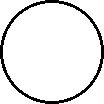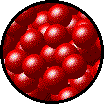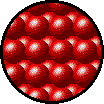3 States of Matter
Gases, liquids and solids are all made up of microscopic particles, but the behaviors of these particles differ in the three phases. Look below to see how the molecules move and are arranged differently in the three most common states of matter.
Gas Molecules Liquid Molecules Solid Molecules



-
Particles in a:
- gas are well separated with no regular arrangement.
- liquid are close together with no regular arrangement.
- solid are tightly packed, usually in a regular pattern.
-
Particles in a:
- gas vibrate and move freely at high speeds.
- liquid vibrate, move about, and slide past each other.
- solid vibrate (jiggle) but generally do not move from place to place.
The following table summarizes properties of gases, liquids, and solids and identifies the microscopic behavior responsible for each property.
| Some Characteristics of Gases, Liquids and Solids and the Microscopic Explanation for the Behavior | ||
|---|---|---|
| gas | liquid | solid |
|
assumes the shape and volume of its container particles can move past one another |
assumes the shape of the part of the container which it occupies particles can move/slide past one another |
retains a fixed volume and shape rigid - particles locked into place |
|
compressible lots of free space between particles |
not easily compressible little free space between particles |
not easily compressible little free space between particles |
|
flows easily particles can move past one another |
flows easily particles can move/slide past one another |
does not flow easily rigid - particles cannot move/slide past one another |





0 General Document comments
0 Sentence and Paragraph comments
0 Image and Video comments
In your own words, describe how the molecules appear
New Conversation
Hide Full Comment
In your own words, how do these liquid molecules move compared to gas molecules?
New Conversation
Hide Full Comment
Is there ever a time when these molecules would stop moving? Explain.
New Conversation
Hide Full Comment
General Document Comments 0

